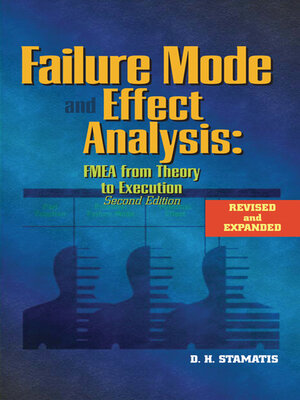
Sign up to save your library
With an OverDrive account, you can save your favorite libraries for at-a-glance information about availability. Find out more about OverDrive accounts.
Find this title in Libby, the library reading app by OverDrive.



Search for a digital library with this title
Title found at these libraries:
| Library Name | Distance |
|---|---|
| Loading... |
Author D. H. Stamatis has updated his comprehensive reference book on failure mode and effect analysis (FMEA). This is one of the most comprehensive guides to FMEA and is excellent for professionals with any level of understanding.!—nl—This book explains the process of conducting system, design, process, service, and machine FMEAs, and provides the rationale for doing so. Readers will understand what FMEA is, the different types of FMEA, how to construct an FMEA, and the linkages between FMEA and other tools. Stamatis offer a summary of tools/methodologies used in FMEA along with a glossary to explain key terms and principles. The updated edition includes information about the new ISO 9000:2000 standard, the Six Sigma approach to FMEA, a special section on automotive requirements related to ISO/TS 16949, the "robustness" concept, and TE 9000 and the requirements for reliability and maintainability. Also includes FMEA forms and samples, design review checklist, criteria for evaluation, basic reliability formulae and conversion failure factors, guidelines for RPN calculations and designing a reasonable safe product, and diagrams, and examples of FMEAs with linkages to robustness.|Author D. H. Stamatis has updated his comprehensive reference book on failure mode and effect analysis (FMEA). This is one of the most comprehensive guides to FMEA and is excellent for professionals with any level of understanding.!—nl—This book explains the process of conducting system, design, process, service, and machine FMEAs, and provides the rationale for doing so. Readers will understand what FMEA is, the different types of FMEA, how to construct an FMEA, and the linkages between FMEA and other tools. Stamatis offer a summary of tools/methodologies used in FMEA along with a glossary to explain key terms and principles. The updated edition includes information about the new ISO 9000:2000 standard, the Six Sigma approach to FMEA, a special section on automotive requirements related to ISO/TS 16949, the "robustness" concept, and TE 9000 and the requirements for reliability and maintainability. Also includes FMEA forms and samples, design review checklist, criteria for evaluation, basic reliability formulae and conversion failure factors, guidelines for RPN calculations and designing a reasonable safe product, and diagrams, and examples of FMEAs with linkages to robustness.







